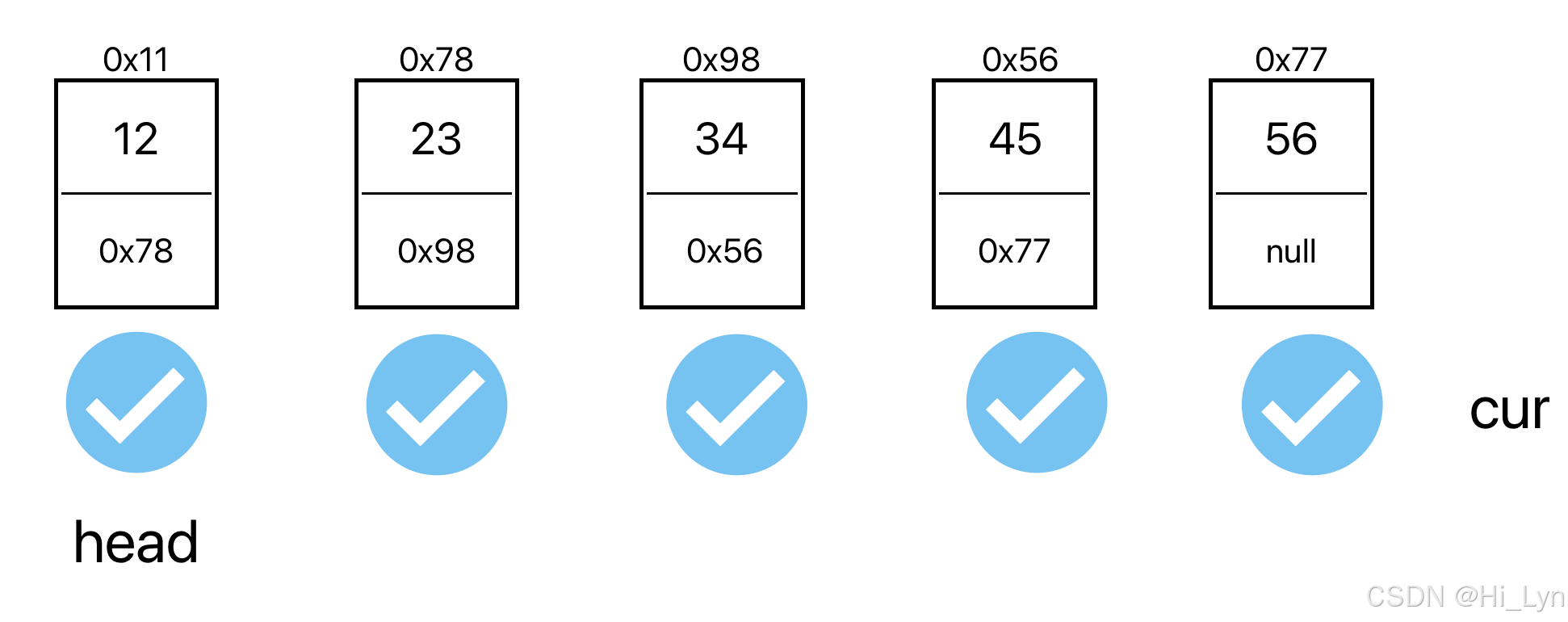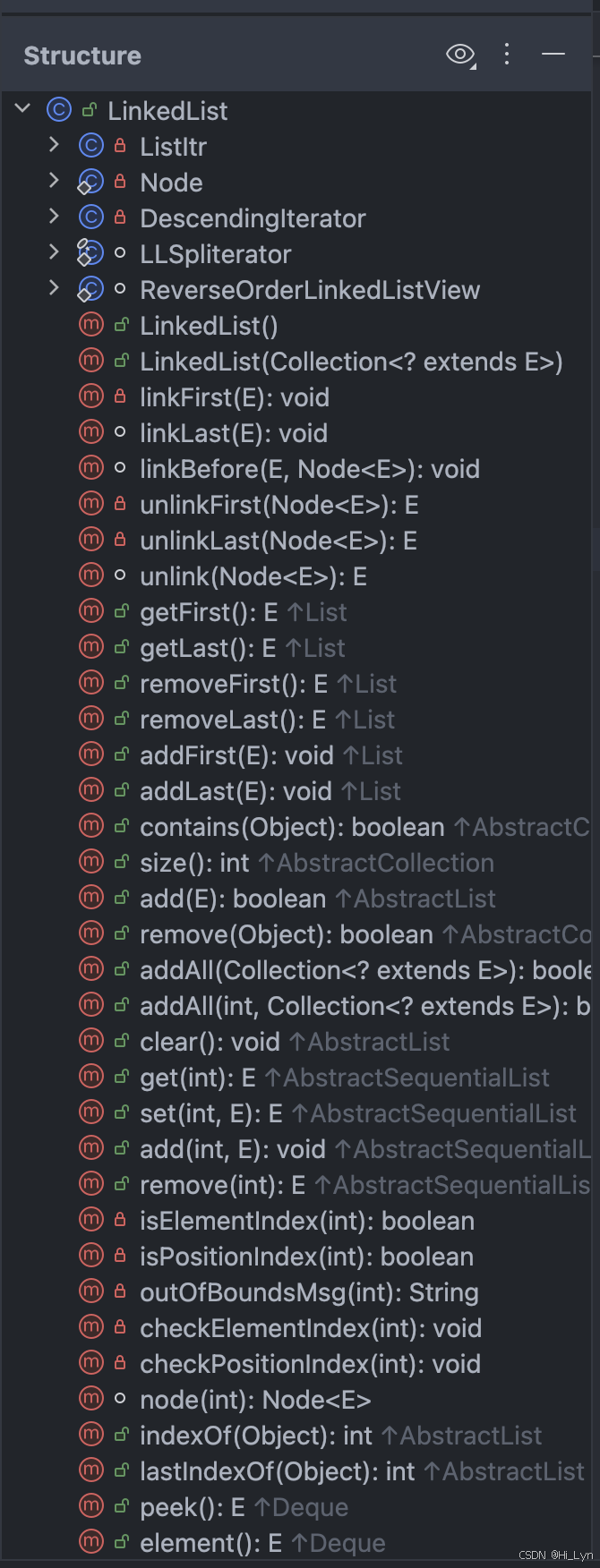一、链表的概念和结构
链表是一种物理存储结构上非连续存储结构,数据元素的逻辑顺序是通过链表中的引用链接次序实现的,在逻辑上连续,物理内存上不连续
链表的形式有很多,我们主要掌握两种:
- 无头单向非循环链表:结构简单,一般不会单独用来存数据,实际中更多的是作为其他数据结构的子结构,如哈希桶、图的邻接表等等,另外这种结构在笔试面试中会出现很多
- 无头双向链表:在Java的集合框架库中LinkedList底层实现就是无头双向链表
二、无头单向非循环链表的实现
1. 定义一个链表
public class MySingleList {
static class ListNode {
public ListNode next;//下一个节点的地址
public int val;//节点的值域
public ListNode(int val) {
this.val = val;
}
}
public ListNode head;//表示当前链表的头节点
}
2. 创建节点
public void creatList(){
ListNode node1 = new ListNode(12);
ListNode node2 = new ListNode(23);
ListNode node3 = new ListNode(34);
ListNode node4 = new ListNode(45);
ListNode node5 = new ListNode(56);
这样之后我们只创建了单独的数据,如图所示

3.形成链表
node1.next = node2;
node2.next = node3;
node3.next = node4;
node4.next = node5;
this.head = node1;

三、无头单向非循环链表的几种方法
1.打印元素
定义一个cur相当于head,如果cur不等于空,那么就打印对应的内容

public void display(){
ListNodes cur = head;
while (cur != null){
System.out.print(cur.val + " ");
cur = cur.next;
}
System.out.println();
}
//输出结果
12 23 34 45 56
Process finished with exit code 0
2.头插法
在head的前面插入一个元素,注意,在插入的的时候先绑定后面的节点信息

public void addFirst(int data){
ListNodes nodes = new ListNodes(data);
nodes.next = head;
head = nodes;
}
//输出结果
666 12 23 34 45 56
Process finished with exit code 0
3.尾插法
当cur.next==null时说明整个链表遍历完成了,cur所指向的节点就是尾巴节点,是最后一个节点的位置

public void addLast(int data){
ListNodes nodes = new ListNodes(data);
ListNodes cur = head;
if (cur == null){
head = nodes;
return;
}
while (cur.next != null){
cur = cur.next;
}
cur.next = nodes;
}
//输出结果
12 23 34 45 56 666
Process finished with exit code 0
4.得到单链表的长度
public int size(){
ListNodes cur = head;
int count = 0;
while (cur != null){
count++;
cur = cur.next;
}
return count;
}
//输出结果
7
Process finished with exit code 0
5.任意位置插入
需要判断是否为第一个和最后一个节点然后再进行插入

public ListNodes findnodeSubone(int index){
ListNodes cur = head;
while (index -1 != 0){
cur = cur.next;
index--;
}
return cur;
}
public void addIndex(int index,int data){
if (index < 0 || index > size()){
System.out.println("位置不合法!");
}
if (index == 0 ){
addFirst(data);
return;
}
if (index == size()){
addLast(data);
return;
}
ListNodes cur = findnodeSubone(index);
ListNodes nodes = new ListNodes(data);
nodes.next = cur.next;
cur.next = nodes;
}
//运行结果
666 12 23 666 34 45 56 666
Process finished with exit code 0
6.查找是否包含关键字key在单链表中
public boolean contains(int key){
ListNodes cur = head;
while (cur != null){
if (cur.val == key){
return true;
}
cur = cur.next;
}
return false;
}
//运行结果
true
Process finished with exit code 0
7.删除第一次出现关键字key的节点
public ListNodes Search(int key){
ListNodes cur = head;
while (cur.next != null){
if (cur.next.val == key){
return cur;
}
cur = cur.next;
}
return null;
}
public void remove(int key){
if (head == null){
return;
}
if (head.val == key){
head = head.next;
return;
}
ListNodes cur = Search(key);
if (cur ==null){
System.out.println("没有要删除的数字");
return;
}
ListNodes del = cur.next;
cur.next = del.next;
}
//输出结果
12 23 666 34 45 56 666
Process finished with exit code 0
8.删除所有值为key的节点
cur代表当前要删除的节点,prev代表要删除节点的前驱
public void removeAll(int key){
ListNodes cur = head;
ListNodes prev = Search(key);
if (head == null){
return;
}
while (cur != null){
if (cur.val == key){
prev.next = cur.next;
cur = cur.next;
}
else {
prev = cur;
cur = cur.next;
}
}
if (head.val == key){
head = head.next;
}
}
//输出结果
12 23 34 45 56
Process finished with exit code 0
9.清空单链表
只需让头节点为空即可
public void clean(){
this.head = null;
}
//输出结果
Process finished with exit code 0
四、无头双向链表的模拟实现
1.头插法
public void addFirst(int val){
ListNode next;
ListNode prev;
ListNode node = new ListNode(val);
if (head != null){
node.next = head;
head.prev = node;
head = node;
}else {
head = node;
last = node;
}
}
2.尾插法
public void addLast(int val){
ListNode node = new ListNode(val);
if (head == null){
head = node;
last = node;
}else {
last.next = node;
node.prev = last;
last = last.next;
}
}
3.任意位置插入
public ListNode search(int index){
ListNode cur = head;
while (index != 0){
cur = cur.next;
index--;
}
return cur;
}
public void addIndex(int data,int index){
if (index < 0 || index > size()){
//throw new no("位置不合法");
}
if (index == 0){
addFirst(data);
}
if (index == size()){
addLast(data);
}
ListNode cur = search(index);
ListNode node = new ListNode(data);
node.next = cur;
cur.prev .next = node;
node.prev = cur.prev;
cur.prev = node;
}
4.删除第一次出现关键字key的节点
public void remove(int key){
ListNode cur = head;
while (cur != null){
if (cur.val == key){
if (cur == head){
//删除头节点
head = head.next;
if (head != null){
//考虑只有一个节点的情况下
head.prev = null;
}else {
last =null;
}
}else {
//删除中间节点和尾巴节点
if (cur.next != null){
cur.prev.next = cur.next;
cur.next.prev = cur.prev;
}else {
cur.prev.next = cur.next;
last = last.prev;
}
}
return;
}else {
cur = cur.next;
}
}
}
5.删除所有值为key的节点
public void removeAll(int key){
ListNode cur = head;
while (cur != null){
if (cur.val == key){
if (cur == head){
//删除头节点
head = head.next;
if (head != null){
//考虑只有一个节点的情况下
head.prev = null;
}else {
last =null;
}
}else {
//删除中间节点和尾巴节点
if (cur.next != null){
cur.prev.next = cur.next;
cur.next.prev = cur.prev;
}else {
cur.prev.next = cur.next;
last = last.prev;
}
}
cur = cur.next;
}else {
cur = cur.next;
}
}
}
6.清除链表
public void clear(){
ListNode cur = head;
while (cur != null){
ListNode curNext = cur.next;
cur.prev = null;
cur.next = null;
cur = curNext;
}
head = null;
last = null;
}
五、LinkedList
什么是LinkedList?
LinkedList的底层是双向链表结构,由于链表没有将元素存储在连续的空间中,元素存储在单独节点中,然后通过引用将节点链接起来了,因此在任意位置插入或者删除元素时,不需要搬移元素,效率比较高
1.LinkedList的使用
LinkedList的构造
public class test {
public static void main(String[] args) {
//构造一个空的LinkedList
List<Integer> list = new LinkedList<>();
List<String> list1 = new LinkedList<>();
list1.add("hello");
list.add(666);
System.out.println(list);
System.out.println(list1);
}
}
2.LinkedList的常用方法

3.ArrayList和LinkedList的区别
- ArrayList在物理上连续存储,LinkedList在逻辑上连续存储,在物理上不一定连续存储
- ArrayList头插效率低,插入需要扩容,LinkedList没有容量的概念
- 应用场景:ArrayList应用于元素高效存储+频繁访问,LinkedList适用于在任意位置插入和删除数据























 1376
1376

 被折叠的 条评论
为什么被折叠?
被折叠的 条评论
为什么被折叠?








